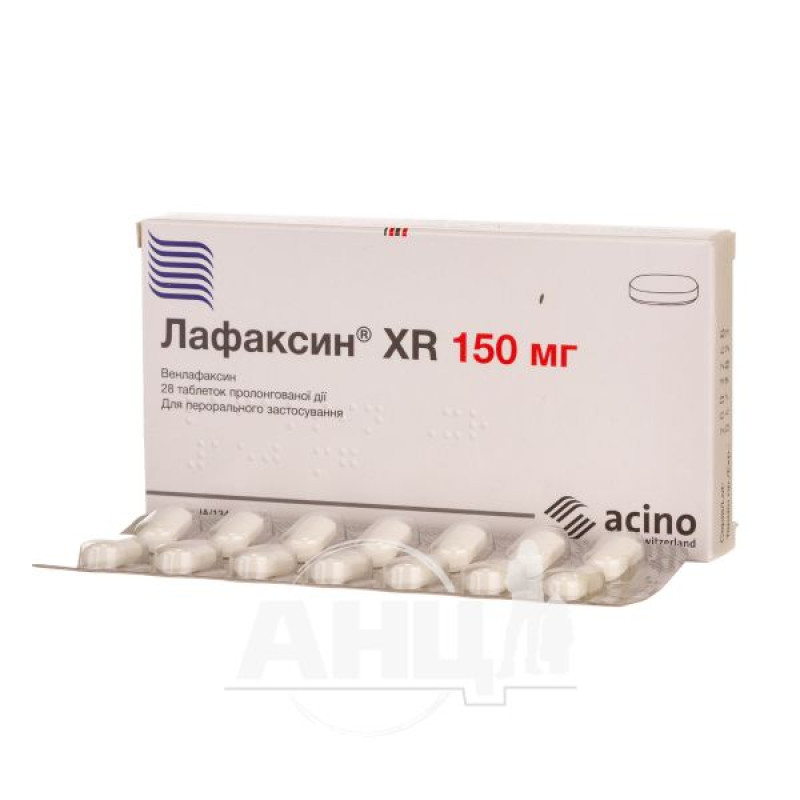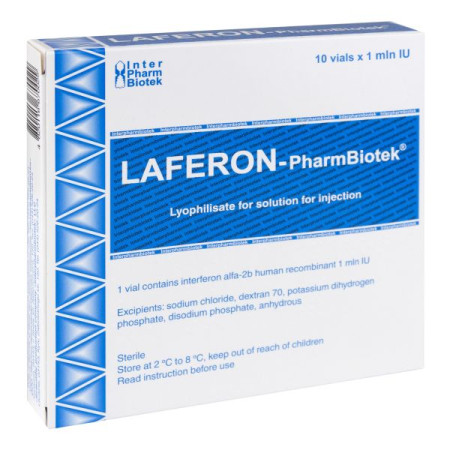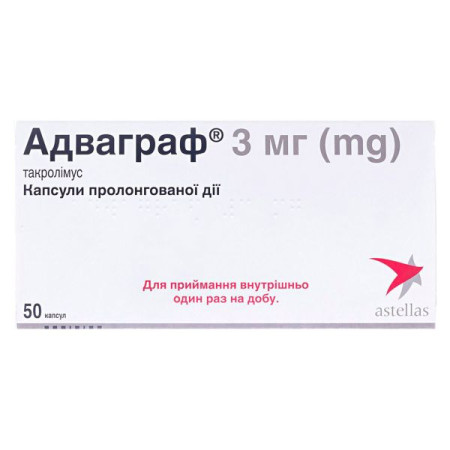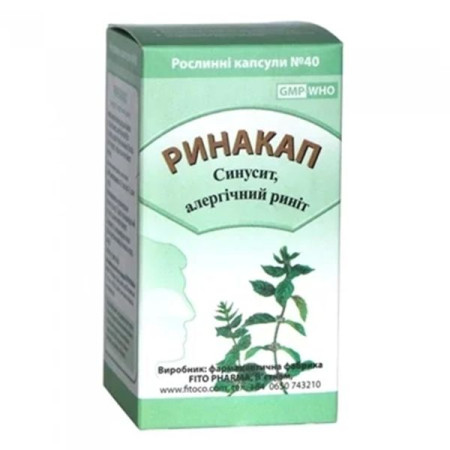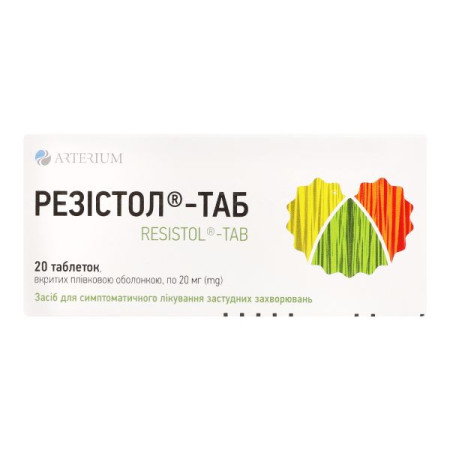Lafaxine XR tablets 150 mg No. 28
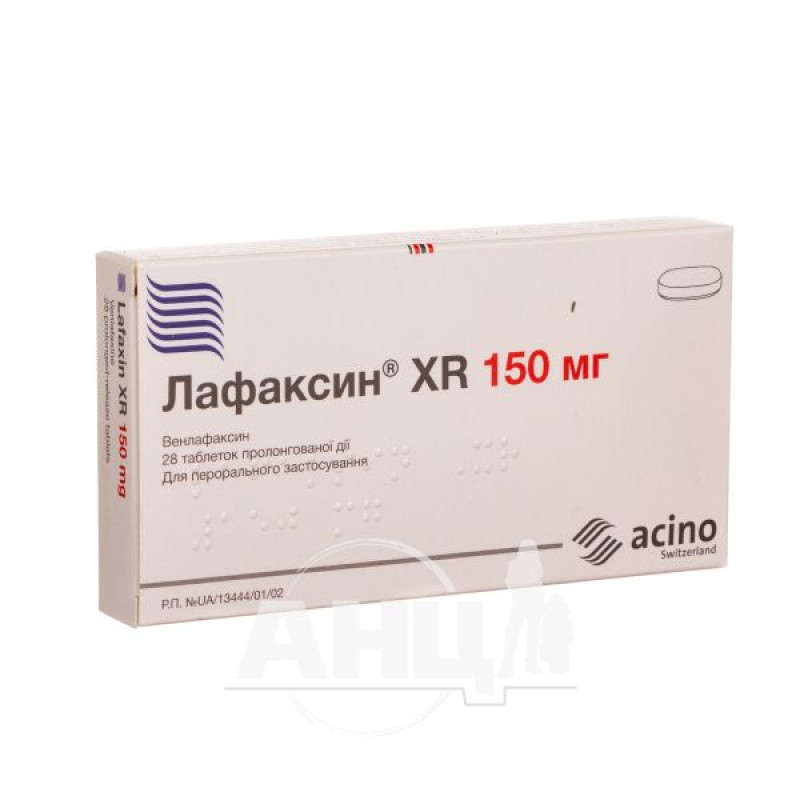
Instructions for Lafaxin XR tablets 150 mg No. 28
Composition
active ingredient: venlafaxine hydrochloride;
1 tablet contains venlafaxine hydrochloride 169.70 mg, equivalent to venlafaxine base 150 mg;
excipients: calcium hydrogen phosphate, dihydrate; hypromellose K-100; polyacrylate dispersion 30%; colloidal anhydrous silicon dioxide; magnesium stearate;
shell: polyvinyl acetate dispersion 30%, triethyl citrate, polyvinyl alcohol macrogol graft copolymer, talc, carnauba wax.
Dosage form
Extended-release tablets.
Main physicochemical properties: round, film-coated tablets, speckled, white to almost white in color.
Pharmacotherapeutic group
Antidepressants. ATX code N06A X16.
Pharmacological properties
Pharmacodynamics
Mechanism of action.
The antidepressant mechanism of action of venlafaxine in humans is thought to be related to an increase in neurotransmitter activity in the central nervous system. Preclinical studies have shown that venlafaxine and its major metabolite O-desmethylvenlafaxine (ODV) are inhibitors of serotonin and norepinephrine reuptake. In addition, venlafaxine weakly inhibits dopamine reuptake. Venlafaxine and its active metabolite reduce β-adrenergic responses after single administration (single dose) and chronic administration. Venlafaxine and ODV are very similar in their overall effects on neurotransmitter reuptake and receptor binding.
In rodent brain, venlafaxine shows little affinity for muscarinic, cholinergic, H1-histaminergic, or α1-adrenergic receptors in vitro. Pharmacological activity at these receptors may prevent a variety of side effects seen with other antidepressants, such as anticholinergic, sedative, and cardiovascular side effects.
Venlafaxine does not inhibit monoamine oxidase (MAO).
In vitro studies have shown that venlafaxine has virtually no affinity for receptors sensitive to opiate or benzodiazepines.
Clinical efficacy and safety.
Major Depressive Episodes. The efficacy of immediate-release venlafaxine in the treatment of major depressive episodes was demonstrated in five randomized, double-blind, placebo-controlled, short-term studies of 375 mg/day of 4 to 6 weeks duration. The efficacy of extended-release venlafaxine in the treatment of major depressive episodes was demonstrated in two short-term, placebo-controlled studies of 8 and 12 weeks duration, using doses ranging from 75 to 225 mg/day.
In a long-term study, adult outpatients who were treated with extended-release venlafaxine (75, 150, or 225 mg) in an 8-week open-label study were randomly assigned to receive the same dose of extended-release venlafaxine or placebo and were followed for 26 weeks for relapse.
In a second long-term study, the efficacy of venlafaxine in preventing recurrence of depressive episodes was confirmed for 12 months in a placebo-controlled, double-blind clinical trial in adult outpatients with recurrent major depressive episodes who had received venlafaxine (100 to 200 mg/day, divided into 2 doses/day) for the previous depressive episode.
Generalized Anxiety Disorder: The efficacy of venlafaxine extended-release for the treatment of generalized anxiety disorder was demonstrated in two 8-week, fixed-dose (75 to 225 mg/day) placebo-controlled studies, a 6-month, fixed-dose (75 to 225 mg/day) placebo-controlled study, and a 6-month, flexible-dose (37.5 mg, 75 mg, and 150 mg/day) placebo-controlled study in adult outpatients.
While there was evidence of superiority over placebo even for the 37.5 mg/day dose, this dose was not as consistently effective as higher doses.
Social Anxiety Disorder: The efficacy of venlafaxine extended-release for the treatment of social anxiety disorder was demonstrated in four double-blind, 12-week, multicenter, placebo-controlled, parallel-group, flexible-dose studies and one double-blind, 6-month, placebo-controlled, parallel-group, fixed/flexible-dose study in adult outpatients. Patients received doses ranging from 75 to 225 mg/day. In the 6-month study, there was no evidence of greater efficacy in the 150–225 mg/day group compared with the 75 mg/day group.
In addition, efficacy was confirmed in a double-blind, placebo-controlled, parallel-group, long-term safety, efficacy, and relapse prevention study in adult outpatients undergoing open-label treatment. Patients continued to receive the same dose of venlafaxine extended-release that was used at the end of the open-label phase (75, 150, or 225 mg).
Cardiac electrophysiology: In a large QT study in healthy volunteers at a supratherapeutic dose of 450 mg/day (225 mg twice daily), venlafaxine did not prolong the QT interval to a clinically significant extent. However, post-marketing reports of QT prolongation/torsades de pointes and ventricular arrhythmias have been reported, particularly in cases of overdose or in patients with other risk factors (see sections 4.4, 4.8 and 4.8).
Pharmacokinetics
Venlafaxine is extensively metabolized, primarily to the active metabolite O-desmethylvenlafaxine (ODV). The mean ± SD (standard deviation) plasma half-lives of venlafaxine and ODV are 5 ± 2 h and 11 ± 2 h, respectively. Steady-state concentrations of venlafaxine and ODV are achieved within 3 days of multiple oral dosing. Venlafaxine and ODV exhibit linear kinetics over the dose range of 75 mg to 450 mg/day.
Absorption. After a single oral dose of immediate-release venlafaxine, approximately 92% of venlafaxine is absorbed. Absolute bioavailability is 40–45%, which is due to first-pass metabolism. After immediate-release venlafaxine, peak plasma concentrations of venlafaxine and ODV are reached within 2 and 3 hours, respectively. After a dose of extended-release venlafaxine, peak plasma concentrations of venlafaxine and ODV are reached within 5.5 and 9 hours, respectively. When the same doses of venlafaxine are administered as either the immediate-release or extended-release tablet, extended-release venlafaxine provides a slower rate but the same extent of absorption as the immediate-release tablet. Food intake does not affect the bioavailability of venlafaxine and ODV.
Distribution: Venlafaxine and ODV are minimally bound to human plasma proteins at therapeutic concentrations (27% and 30%, respectively). The volume of distribution of venlafaxine at steady state is 4.4 ± 1.6 L/kg after intravenous administration.
Biotransformation. Venlafaxine is extensively metabolized in the liver. In vitro and in vivo studies indicate that venlafaxine is biotransformed by the enzyme CYP2D6 to form its major active metabolite, ODV. In vitro and in vivo studies indicate that venlafaxine is metabolized by the enzyme CYP3A4 to form its minor, less active metabolite, N-desmethylvenlafaxine. In vitro and in vivo studies indicate that venlafaxine itself is a weak inhibitor of CYP2D6. Venlafaxine did not inhibit CYP1A2, CYP2C9, or CYP3A4.
Elimination: Venlafaxine and its metabolites are eliminated primarily by the kidneys. Approximately 87% of a venlafaxine dose is excreted in the urine within 48 hours as either unchanged venlafaxine (5%), unconjugated ODV (29%), conjugated ODV (26%), or other minor inactive metabolites (27%). The mean ± SD steady-state plasma clearances of venlafaxine and ODV are 1.3 ± 0.6 L/h/kg and 0.4 ± 0.2 L/h/kg, respectively.
Certain patient groups
Age and gender: The age and gender of the patient do not significantly affect the pharmacokinetics of venlafaxine and ODV.
CYP2D6 extensive/poor metabolizers. Plasma concentrations of venlafaxine are higher in CYP2D6 poor metabolizers than in extensive metabolizers. Since the total exposure (AUC) to venlafaxine and ODV is similar in poor and extensive metabolizers, there is no need for different venlafaxine dosing regimens for these two patient groups.
Hepatic impairment. In patients with Child-Pugh Class A (mild hepatic impairment) and Child-Pugh Class B (moderate hepatic impairment), the half-life of venlafaxine and ODV was prolonged compared with patients with normal hepatic function. The oral clearance of venlafaxine and ODV was reduced. There was a wide degree of interpatient variability in these parameters. Data on the use of the drug in patients with severe hepatic impairment are limited (see section 4.2).
Renal impairment: In patients on dialysis, the half-life of venlafaxine was prolonged by approximately 180% and clearance was reduced by approximately 57% compared to patients with normal renal function, while the half-life of ODV was prolonged by approximately 142% and clearance was reduced by approximately 56%. Dosage adjustment is required in patients with severe renal impairment and in patients requiring hemodialysis (see Dosage and Administration).
Indication
- Treatment of major depressive episodes.
- Treatment of generalized anxiety disorders.
- Treatment of social anxiety disorder (social phobia).
- Treatment of panic disorder with or without agoraphobia.
Contraindication
Hypersensitivity to the active substance or any of the excipients.
Concomitant treatment with irreversible monoamine oxidase inhibitors (MAOIs) is contraindicated due to the risk of serotonin syndrome with symptoms such as agitation, tremor and hyperthermia. Venlafaxine should not be started for at least 14 days after discontinuation of treatment with irreversible MAOIs. Venlafaxine should be discontinued at least 7 days before initiating treatment with an irreversible MAOI (see sections 4.4 and 4.5).
Interaction with other medicinal products and other types of interactions
Monoamine oxidase inhibitors (MAOIs)
Irreversible non-selective MAO inhibitors
Venlafaxine should not be used in combination with irreversible non-selective MAO inhibitors. Venlafaxine should not be started earlier than 14 days after the end of treatment with irreversible non-selective MAO inhibitors. Venlafaxine should be discontinued at least 7 days before starting treatment with an irreversible non-selective MAO inhibitor (see sections "Contraindications" and "Special Instructions").
Reversible selective MAO-A inhibitors (moclobemide)
Due to the risk of serotonin syndrome, the combination of venlafaxine with reversible selective MAO inhibitors, such as moclobemide, is contraindicated. Venlafaxine should not be started earlier than 14 days after the end of therapy with reversible MAO inhibitors. After discontinuation of venlafaxine, at least 7 days should be allowed before starting therapy with reversible MAO inhibitors (see section "Special instructions").
Reversible non-selective MAO inhibitors (linezolid)
Concomitant use of the antibiotic linezolid (a weak reversible non-selective MAO inhibitor) with venlafaxine is contraindicated (see section "Special warnings and precautions for use").
Serious adverse reactions have been reported in patients who have recently discontinued MAO inhibitors and started venlafaxine therapy or who have discontinued venlafaxine therapy shortly before starting MAO inhibitors. These reactions included tremor, myoclonus, hyperhidrosis, nausea, vomiting, hot flushes, dizziness, and hyperthermia with features similar to neuroleptic malignant syndrome, seizures, and death.
Serotonin syndrome
As with other serotonergic agents, serotonin syndrome, a potentially life-threatening condition, may develop during treatment with venlafaxine; in particular when used concomitantly with medicinal products that affect the serotonergic neurotransmitter system (including triptans, SSRIs [selective serotonin reuptake inhibitors], SNRIs [selective serotonin and norepinephrine reuptake inhibitors], amphetamine, lithium, sibutramine, St. John's wort [Hypericum perforatum], fentanyl and its analogues, tramadol, pethidine, methadone, pentazocine and buprenorphine), with medicinal products that disrupt serotonin metabolism (e.g. MAO inhibitors such as methylene blue), or with serotonin precursors (e.g. tryptophan supplements), with antipsychotics or other dopamine antagonists (see sections "Contraindications" and "Special instructions for use").
If concomitant treatment with venlafaxine and an SSRI, SNRI or serotonin receptor antagonist (triptan) is clinically necessary, close monitoring of the patient is recommended, especially at the beginning of treatment and in case of dose increase. Concomitant use of venlafaxine and serotonin precursors (e.g. tryptophan supplements) is not recommended (see section 4.4).
Agents that affect the CNS
The risk of using venlafaxine in combination with other drugs that affect the central nervous system (CNS) has not been systematically studied. Therefore, caution should be exercised when using venlafaxine in combination with other drugs that affect the CNS.
Ethanol
The reduction in mental and motor activity under the influence of ethanol is not enhanced after the use of venlafaxine. However, as with all active substances acting on the CNS, patients should refrain from drinking alcoholic beverages.
QT prolonging agents
The risk of QT prolongation and/or ventricular arrhythmias (e.g. torsades de pointes) is increased by concomitant use with other medicinal products known to prolong the QT interval. Therefore, concomitant use of such medicinal products should be avoided (see section 4.4).
These include the following classes of drugs:
- class Ia and III antiarrhythmics (e.g. quinidine, amiodarone, sotalol, dofetilide);
- some antipsychotics (e.g. thioridazine);
- some macrolides (e.g. erythromycin);
- some antihistamines;
- some quinolone antibiotics (e.g. moxifloxacin).
This list is not exhaustive. Combination with other individual drugs that can significantly prolong the QT interval should be avoided.
Effects of other drugs on venlafaxine
A study of the pharmacokinetics of ketoconazole in CYP2D6 extensive metabolizers (EMs) and poor metabolizers (PMs) demonstrated an increase in venlafaxine AUC (70% and 21% in CYP2D6 EMs and PMs, respectively) and AUC (33% and 23% in CYP2D6 EMs and PMs, respectively) after ketoconazole administration. Concomitant use of CYP3A4 inhibitors (e.g., atazanavir, clarithromycin, indinavir, itraconazole, voriconazole, posaconazole, ketoconazole, nelfinavir, ritonavir, saquinavir, telithromycin) and venlafaxine may increase venlafaxine and O-desmethylvenlafaxine levels. Therefore, caution should be exercised when a CYP3A4 inhibitor is coadministered with venlafaxine.
Effect of venlafaxine on other drugs
Lithium
Serotonin syndrome may occur when venlafaxine and lithium are used concomitantly (see “Serotonin syndrome” below).
Diazepam
Venlafaxine does not affect the pharmacokinetics and pharmacodynamics of diazepam and its active metabolite desmethyldiazepam. Diazepam does not affect the pharmacokinetics of venlafaxine and O-desmethylvenlafaxine. It is unknown whether there is a pharmacokinetic or pharmacodynamic interaction with other benzodiazepines.
Imipramine
Venlafaxine does not affect the pharmacokinetics of imipramine and 2-hydroxyimipramine. A dose-dependent increase in the AUC of 2-hydroxydesipramine of 2.5- to 4.5-fold was observed when venlafaxine was administered at a dose of 75-150 mg per day. Imipramine did not affect the pharmacokinetics of venlafaxine and O-desmethylvenlafaxine. The clinical significance of this interaction is unknown. Caution should be exercised when venlafaxine and imipramine are coadministered.
Haloperidol
A pharmacokinetic study of venlafaxine with haloperidol showed a 42% decrease in total oral clearance, a 70% increase in AUC, and an 88% increase in Cmax, but the half-life of haloperidol remained unchanged. This should be considered if the patient is receiving concomitant treatment with haloperidol and venlafaxine. The clinical significance of this interaction is unknown.
Risperidone
Venlafaxine increased the AUC of risperidone by 50%, but did not significantly alter the pharmacokinetic profile of the total active component (risperidone + 9-hydroxyrisperidone). The clinical significance of this interaction is unknown.
Metoprolol
Concomitant administration of venlafaxine and metoprolol to healthy volunteers in a pharmacokinetic interaction study resulted in an increase in plasma concentrations of metoprolol by approximately 30–40% without changes in plasma concentrations of its active metabolite alpha-hydroxymetoprolol. The clinical significance of these findings in patients with hypersensitivity is unknown. Metoprolol did not alter the pharmacokinetic profile of venlafaxine or its active metabolite O-desmethylvenlafaxine. Caution should be exercised when venlafaxine and metoprolol are coadministered.
Indinavir
A pharmacokinetic study with indinavir showed a 28% decrease in AUC and a 36% decrease in Cmax of indinavir. Indinavir did not affect the pharmacokinetics of venlafaxine and O-desmethylvenlafaxine. The clinical significance of this interaction is unknown.
Medicinal products metabolized by cytochrome P450 isoenzymes
In vivo studies indicate that venlafaxine is a relatively weak inhibitor of CYP2D6. Venlafaxine does not inhibit CYP3A4 (alprazolam and carbamazepine), CYP1A2 (caffeine), and CYP2C9 (tolbutamide) or CYP2C19 (diazepam) in vivo.
Oral contraceptives
Unintended pregnancies have been reported in postmarketing experience in women taking oral contraceptives while taking venlafaxine. There is no clear evidence that the pregnancies were caused by an interaction with venlafaxine. Interaction studies with hormonal contraceptives have not been conducted.
Application features
Suicide/suicidal thoughts or worsening of clinical condition
Depression is associated with an increased risk of suicidal thoughts, self-harm and suicide attempts (suicidal acts). This risk persists until significant remission is achieved. As improvement may not occur in the first few weeks or for a longer period after initiation of treatment, patients should be closely monitored until their condition improves. General experience with antidepressant treatment suggests that the risk of suicide is increased in the early stages of recovery.
Other psychiatric disorders for which venlafaxine is prescribed are also associated with an increased risk of suicidal behaviour. In addition, these conditions may occur concomitantly with depressive illness (major depressive episodes). Therefore, the same precautions should be taken when treating patients with other psychiatric disorders as when treating patients with major depressive disorder.
Close monitoring of patients, especially those at high risk, should accompany drug therapy, especially at the beginning of treatment and after dose changes. Patients (and caregivers of patients) should be warned about the need to monitor for clinical worsening, suicidal behavior or thoughts, and unusual changes in behavior. If such symptoms occur, medical advice should be sought immediately.
Children and adolescents
Lafaxine® XR Asino should not be used in children and adolescents under 18 years of age. Suicidal behavior (suicide attempt and suicidal thoughts) and hostility (predominantly aggression, oppositional behavior, and anger) were observed more frequently in clinical trials in children and adolescents treated with antidepressants than in children and adolescents treated with placebo. If treatment is clinically indicated, the patient should be closely monitored for suicidal symptoms. In addition, long-term safety data in children and adolescents with regard to growth, puberty, and cognitive and behavioral development are lacking.
Serotonin syndrome
As with other serotonergic agents, serotonin syndrome, a potentially life-threatening condition, may occur with venlafaxine treatment, especially when used concomitantly with other agents that may affect serotonergic neurotransmitters (including triptans, SSRIs, SNRIs, amphetamine, lithium, sibutramine, St. John's wort [Hypericum perforatum], fentanyl and its analogues, tramadol, dextromethorphan, tapentadol, pethidine, methadone, pentazocine and buprenorphine), with drugs that disrupt serotonin metabolism (e.g., MAOIs such as methylene blue), with serotonin precursors (e.g., tryptophan supplements), or with neuroleptics or other dopamine antagonists (see sections 4.3 and 4.5).
Symptoms of serotonin syndrome may include mental status changes (e.g., agitation, hallucinations, coma), autonomic instability (e.g., tachycardia, labile blood pressure, hyperthermia), neuromuscular abnormalities (e.g., hyperreflexia, incoordination), and/or gastrointestinal symptoms (e.g., nausea, vomiting, diarrhea). Serotonin syndrome in its most severe form may resemble neuroleptic malignant syndrome (NMS), which includes hyperthermia, muscle rigidity, autonomic instability with possible rapid fluctuations in vital signs and altered mental status.
If concomitant treatment with venlafaxine and other agents that may affect the serotonergic and/or dopaminergic neurotransmitter systems is clinically warranted, close monitoring of the patient is recommended, especially at the beginning of treatment and when the dose is increased.
Concomitant use of venlafaxine with serotonin precursors (e.g., tryptophan supplements) is not recommended.
Angle-closure glaucoma
Mydriasis may occur with venlafaxine. Therefore, it is recommended to carefully monitor the condition of patients with increased intraocular pressure or at risk of developing acute angle-closure glaucoma.
Blood pressure
Dose-related increases in blood pressure have been commonly reported with venlafaxine. Severe increases in blood pressure requiring immediate treatment have been reported in a few post-marketing cases. Blood pressure should be closely monitored in all patients and blood pressure should be normalized before initiating treatment with venlafaxine. It is recommended that blood pressure be measured periodically at the start of treatment and after dose increases. Caution is advised in patients with underlying medical conditions that may be predisposed to increased blood pressure, such as those with cardiac dysfunction.
Heart rate
Heart rate may increase, especially at high doses. Caution should be exercised in patients whose general condition may depend on heart rate.
Heart disease and risk of arrhythmia
Venlafaxine has not been evaluated in patients with recent myocardial infarction or unstable heart disease. Therefore, the drug should be used with caution in these patients.
During post-marketing use of venlafaxine, cases of QTc prolongation, torsades de pointes, ventricular tachycardia, and fatal cardiac arrhythmias have been reported, particularly in the setting of overdose or in the presence of other risk factors. The risk-benefit ratio should be considered before prescribing venlafaxine to patients at high risk of serious cardiac arrhythmias or QT prolongation (see section 5.1).
Convulsions
Convulsions may occur during treatment with venlafaxine. As with all antidepressants, venlafaxine should be used with caution in patients with a history of seizures, and such patients should be closely monitored. If a patient develops seizures, the drug should be discontinued.
Hyponatremia and/or syndrome of inappropriate antidiuretic hormone secretion (SIADH) may occur with venlafaxine. These events have been observed most frequently in patients with hypovolemia or dehydration. Elderly patients, patients taking diuretics, or patients with other causes of dehydration are at increased risk of developing hyponatremia.
Abnormal bleeding
Drugs that inhibit serotonin reuptake may cause decreased platelet function. Bleeding events associated with SSRIs and SNRIs have ranged from ecchymoses, hematomas, epistaxis, and petechiae to gastrointestinal and life-threatening bleeding. SSRIs/SNRIs, including venlafaxine, increase the risk of postpartum hemorrhage (see sections 4.8 and 4.8).
Patients taking venlafaxine are at increased risk of bleeding. Therefore, venlafaxine should be used with caution in patients with bleeding disorders, including those taking anticoagulants or platelet function inhibitors, as with other serotonin reuptake inhibitors.
Serum cholesterol
Clinically significant increases in serum cholesterol were reported in 5.3% of patients treated with venlafaxine and 0.0% of patients treated with placebo in placebo-controlled studies of at least 3 months duration. Serum cholesterol should be monitored during long-term treatment.
Concomitant use with weight loss medications
The safety and efficacy of venlafaxine in combination with weight loss medications, including phentermine, have not been established. Concomitant use of venlafaxine and weight loss medications is not recommended. Venlafaxine is not indicated for weight loss, including when used in combination with other medications.
Mania/hypomania
Patients with mood disorders receiving antidepressants, including venlafaxine, may develop mania or hypomania. As with other antidepressants, venlafaxine should be prescribed with caution in patients with a family history of bipolar disorder.
Aggression
Aggression may develop in some patients receiving antidepressants, including venlafaxine. This has been reported at the beginning of treatment, after dose changes, and upon discontinuation of treatment.
As with other antidepressants, venlafaxine should be prescribed with caution to patients with a history of aggression.
Withdrawal symptoms after stopping treatment
Withdrawal symptoms are known to occur with antidepressants; sometimes these symptoms may be prolonged and severe. Suicide/suicidal thoughts and aggression have been reported in patients when the dosage regimen of venlafaxine is changed or discontinued. Therefore, patients should be closely monitored when the dose is reduced or when treatment is discontinued (see “Suicide/suicidal thoughts or clinical worsening” and “Aggression” earlier in this section). Withdrawal symptoms are common after treatment is discontinued, particularly if treatment is stopped abruptly (see section “Adverse reactions”). In clinical trials, adverse reactions following treatment discontinuation (during and after dose reduction) were observed in approximately 31% of patients treated with venlafaxine and 17% of patients treated with placebo.
The risk of withdrawal symptoms may depend on several factors, including the duration of treatment, the dose and the rate of dose reduction. Dizziness, sensory disturbances (including paraesthesia), sleep disturbances (including insomnia and deep sleep), agitation or restlessness, nausea and/or vomiting, tremor and headache, visual impairment and increased blood pressure are the most commonly reported withdrawal reactions. These symptoms are usually mild to moderate, but in some patients they may be severe. They usually occur within the first few days after discontinuation of treatment, but in very rare cases such symptoms have been observed in patients who accidentally missed a dose. As a rule, these symptoms resolve spontaneously and usually disappear within 2 weeks. In some people they may persist longer (2-3 months or more). Therefore, when discontinuing treatment, it is recommended to gradually reduce the dose of venlafaxine over several weeks or months, depending on the patient's needs (see section "Dosage and administration"). In some patients, discontinuation of treatment may last at least several months.
Sexual dysfunction
Selective serotonin-norepinephrine reuptake inhibitors (SSRIs) may cause symptoms of sexual dysfunction (see section 4.8). There have been reports of persistent sexual dysfunction where symptoms persist despite discontinuation of SSRIs.
Akathisia/psychomotor restlessness
The use of venlafaxine is accompanied by the development of akathisia, which is subjectively characterized by unpleasant or disturbing restlessness, a need to move frequently, and an inability to sit or stand still. This phenomenon most often occurs in the first few weeks of treatment. For patients who develop such symptoms, increasing the dose may be detrimental.
Dry mouth has been reported in 10% of patients treated with venlafaxine. Dryness increases the risk of caries, so patients should be reminded of the importance of dental hygiene.
Diabetes mellitus
In patients with diabetes mellitus, treatment with SSRIs or venlafaxine may affect glycemic control. The doses of insulin and/or oral antidiabetic drugs may need to be adjusted.
Impact on laboratory tests
False-positive results for phencyclidine (PCP) and amphetamine have been reported in immunoassays of urine from patients taking venlafaxine. This is due to the lack of specificity of the immunoassays. Such false-positive test results can be expected several days after discontinuation of venlafaxine therapy. Confirmatory studies, such as gas chromatography/mass spectrometry, can distinguish venlafaxine from PCP and amphetamine.
Sodium
One of the excipients, polyvinyl acetate dispersion 30%, contains sodium. This medicinal product contains less than 1 mmol sodium (23 mg) per tablet, i.e. essentially ‘sodium-free’.
Use during pregnancy or breastfeeding
Pregnancy: There are no adequate data from the use of venlafaxine in pregnant women.
Animal studies have shown reproductive toxicity. The potential risk to humans is unknown. Venlafaxine should be used in pregnant women only if the expected benefit justifies the potential risk.
As with other SSRIs/SNRIs, withdrawal symptoms may occur in neonates if venlafaxine is used before or shortly before delivery. Some neonates exposed to venlafaxine late in the third trimester have experienced complications requiring tube feeding, assisted ventilation, or prolonged hospital stay. These complications may occur immediately after delivery.
Observational data indicate an increased risk (almost 2-fold) of postpartum hemorrhage as a result of exposure to SSRIs/NSAIDs during the month before childbirth (see sections “Special warnings and precautions for use” and “Adverse reactions”).
Epidemiological evidence suggests that use of SSRIs during pregnancy, particularly in late pregnancy, increases the risk of primary pulmonary hypertension of the newborn (PPHN, also called persistent pulmonary hypertension of the newborn). Although no studies have been conducted to investigate the association of PPHN with SSRI use, this risk cannot be excluded with venlafaxine given its mechanism of action (inhibition of serotonin reuptake).
If a woman has used SSRIs/NSAIDs late in pregnancy, the following symptoms may be observed in the newborn: irritability, tremors, muscle hypotonia, inconsolable crying, and difficulty in breastfeeding or falling asleep. These symptoms may occur in the context of serotonergic effects or symptoms of drug exposure. Most of these complications are observed immediately after birth or within 24 hours.
Lactation. Venlafaxine and its active metabolite O-desmethylvenlafaxine are excreted in human milk. During post-marketing use, crying, irritability, and sleep disturbances have been observed in breastfed infants. Symptoms consistent with discontinuation of venlafaxine have also been reported after discontinuation of breast-feeding. A risk to the breast-fed infant cannot be excluded. Therefore, the decision to discontinue venlafaxine should be made in the following cases:
There are no reviews for this product.
There are no reviews for this product, be the first to leave your review.
No questions about this product, be the first and ask your question.



